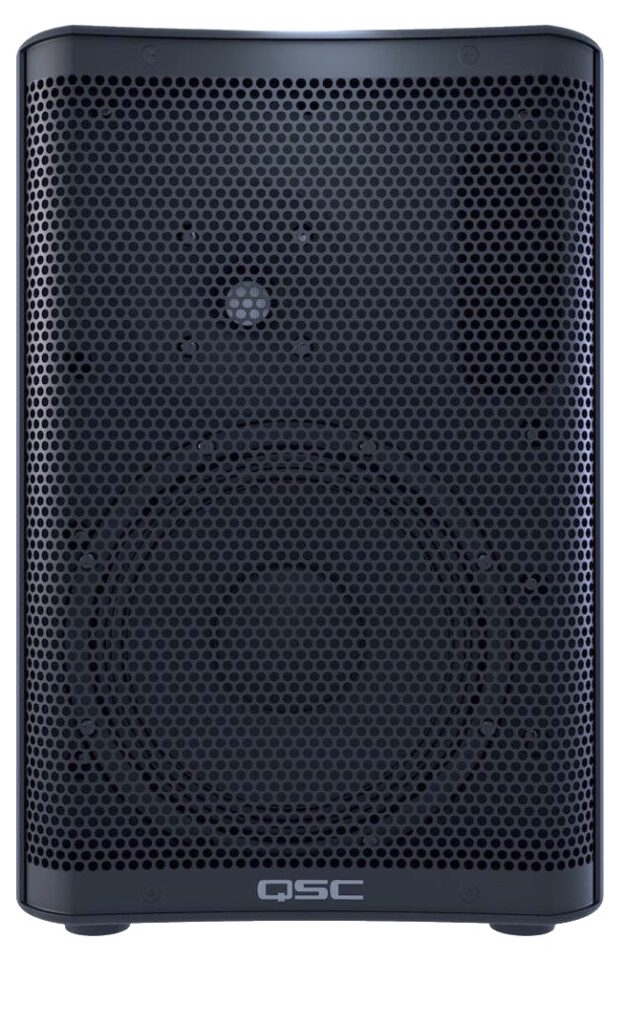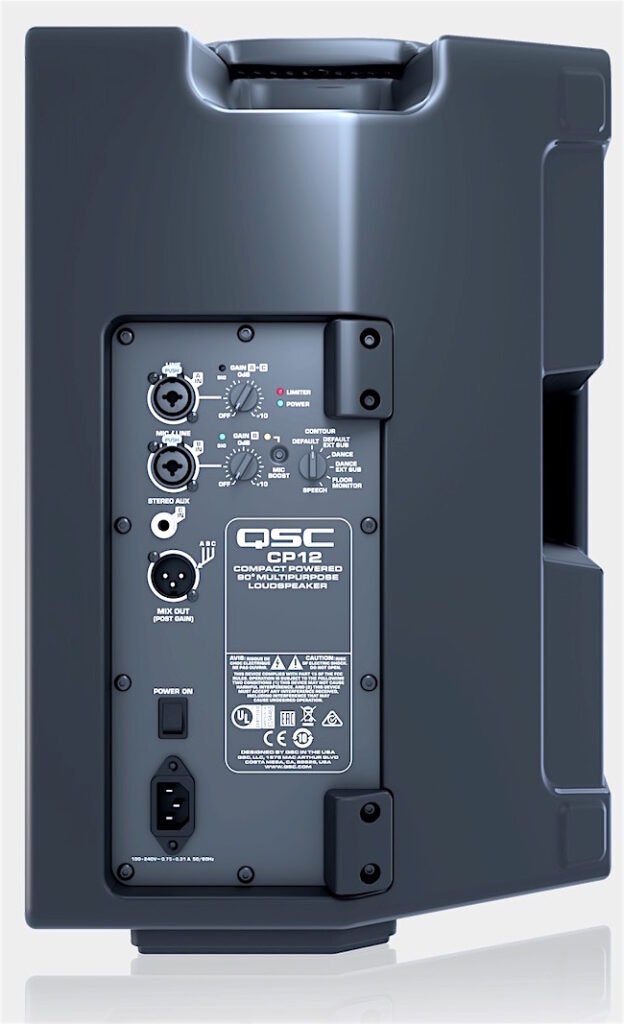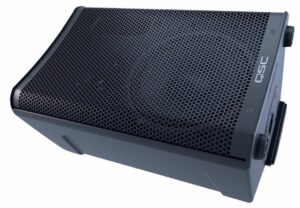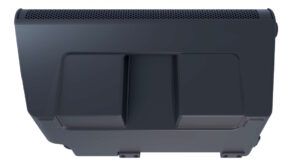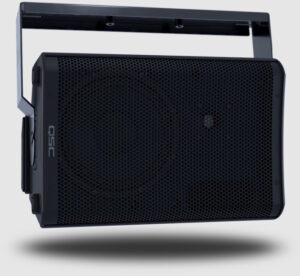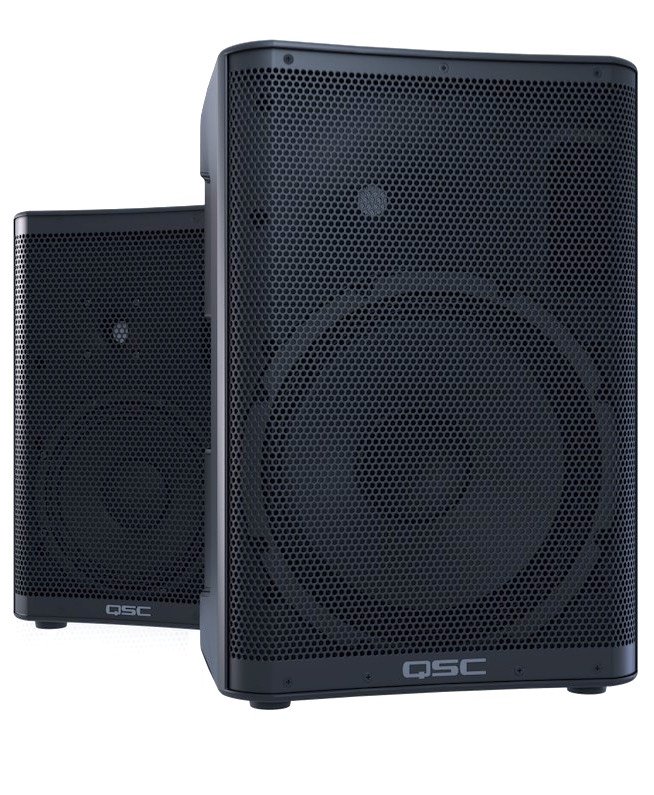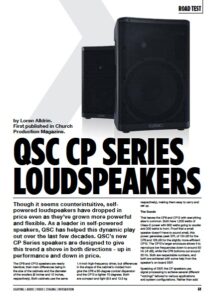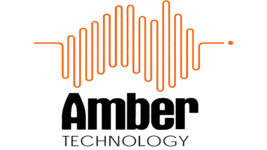News
28 Mar 2019
Roadtest: QSC CP Series Loudspeakers
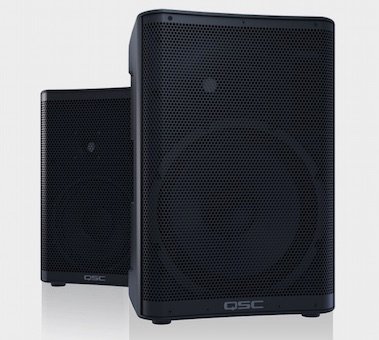
Subscribe to CX E-News
ROADTEST
QSC CP Series Loudspeakers
by Loren Alldrin.
Though it seems counterintuitive, self-powered loudspeakers have dropped in price even as they’ve grown more powerful and flexible. As a leader in self-powered speakers, QSC has helped this dynamic play out over the last few decades. QSC’s new CP Series speakers are designed to give this trend a shove in both directions – up in performance and down in price.
The CP8 and CP12 speakers are nearly identical, their main differences being in the size of the cabinets and the diameter of the woofers (8 inches and 12 inches, respectively). Both cabinets use the same 1.4-inch high-frequency driver, but differences in the shape of the cabinet’s molded horn give the CP8 a 90-degree conical dispersion and the CP12 a tighter 70 degrees. Both are compact and light (9.5 and 13.5 kg respectively), making them easy to carry and set up.
The Goods
That leaves the CP8 and CP12 with everything else in common. Both have 1,000 watts of Class-D power with 800 watts going to woofer and 200 watts to horn. Proof that a small speaker doesn’t have to sound small, this power generates peak SPL of 124 dB for the CP8 and 126 dB for the slightly more-efficient CP12.
The CP12’s larger enclosure allows it to reproduce low frequencies down to around 50 Hz (-6 dB), while the CP8 bottoms out around 55 Hz. Both are respectable numbers, and both are achieved with some help from the speaker’s on-board DSP.
Speaking of DSP, the CP speakers use signal processing to achieve several different “voicings” tailored to various applications and system configurations. Rather than add a screen and menu system (which would drive up cost), these voicings are selected with a simple rotary knob.
Settings include Default, Dance, Floor Monitor and Speech. The Default and Dance voicings also have an external sub setting that engages a high-pass filter at 80 Hz. Well-mastered music needs no help at the speaker, so EQ presets supposedly tailored to specific music styles are ridiculous.
Ignore the label for the CP’s Dance voicing and instead think of it as extra “boom and sizzle” for a blah mix. Actually, don’t give too much thought to any of the DSP labels. Try the four options in various settings, and you may be surprised with what works best.
I bent the rules and used the CP12’s Default setting (no HPF) with a sub for mains, and the CP8’s Dance setting (with HPF) as a floor wedge. The Speech setting, though not subtle in how much it thins the sound, could work for monitoring if extra vocal clarity is needed. The point here is that the CP Series’ DSP settings give you options, and they sound very good in a variety of applications. Spin the knob.
The CP series speakers have three inputs, all of which can be used at the same time. These include two 1/4-inch/XLR combo jacks (inputs A and B) and one 1/8-inch stereo jack (input C). Inputs A and C share a gain knob and signal present LED. Input B has its own gain knob and signal LED, plus a mic boost button that adds 25 dB of gain.
The speaker’s DSP applies a bit of logic to the inputs as well. The Speech setting affects input B only. When the mic boost button is engaged in the Dance voicing, Speech mode is automatically set for input B. In all other settings, the voicings match across all three inputs. (DSP voicing is not applied to the speaker’s XLR mix output.)
Flexibility is the goal, and the CP Series speakers deliver. There are many simple sound reinforcement
setups where these speakers make a mixer unnecessary. Vocal mic plus acoustic guitar plus backing track: check. Vocal mic plus keyboards plus wireless mic: check. Floor wedge with extra “more me” input: check. The list keeps going, and the CP Series speakers sound great in each application.
Note that it takes a pretty strong mic signal to drive the CP speakers to high volume, even with the 25 dB boost. A quiet or distant mic (or a timid voice) may not generate enough volume in certain settings.
Options & Assessment
The CP series also offer options for mounting. The cabinet is angled on one side for floor wedge applications, and a pole socket allows for mounting on a stand (or atop a subwoofer, such as the QSC KS112). An optional yolk allows you to permanently hang the CP Series speakers vertically or horizontally, and adjust their angle.
- Stage monitor
- Side view
- Yoke
QSC has been around the block a few times, and they know how to design speakers that sound great. The CP Series continues this legacy, and I was consistently impressed with the quality (and quantity) of sound these little speakers put out.
If QSC is hoping to sell more subs with its CP speakers, they may have shot themselves in the foot. These speakers put out an impressive amount of bass, rendering a subwoofer unnecessary in most applications. (You will have people asking where the subwoofer is, especially with the CP8.)
Of the two speakers, the CP8 impressed me the most. Though quite a bit smaller than the CP12, its max SPL is just 2 dB lower. Its bass output is more than adequate for most situations, and its wider 90-degree dispersion makes it a better fit for small rooms and floor wedge applications. Better dispersion from the smaller woofer also gives the CP8 a smoother off-axis response.
Great sound, compact size, light weight, flexible inputs, mounting options – the CP Series delivers the goods. Add a three-year warranty for peace of mind, and you’ve got a speaker well worthy of your consideration.
A bit of advice: if your church buys a pair of these speakers, get the optional covers as well. They’ll likely be hauled all over the place and used almost every day.
Brand: QSC
Model: CP Series
Product Info: www.qsc.com
Australia: www.jands.com.au
New Zealand: www.nsl.co.nz
From CX Magazine – March 2019. First published in Church Production Magazine. CX Magazine is Australia and New Zealand’s only publication dedicated to entertainment technology news and issues – available in print and online. Read all editions for free or search our archive www.cxnetwork.com.au
© CX Media
Subscribe
Published monthly since 1991, our famous AV industry magazine is free for download or pay for print. Subscribers also receive CX News, our free weekly email with the latest industry news and jobs.

